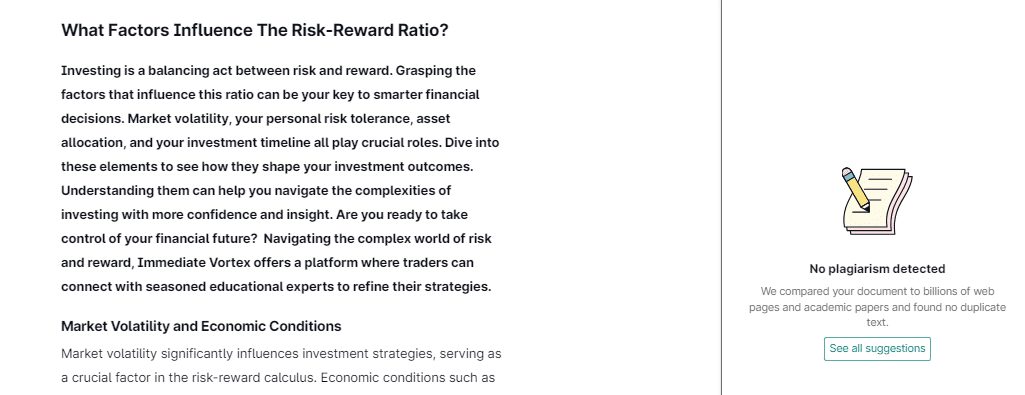Factors Influencing the Risk-Reward Ratio in Investing

Investing is a balancing act between risk and reward. Grasping the factors that influence this ratio can be your key to smarter financial decisions.
Market volatility, your personal risk tolerance, asset allocation, and your investment timeline all play crucial roles.

Dive into these elements to see how they shape your investment outcomes. Understanding them can help you navigate the complexities of investing with more confidence and insight.
Are you ready to take control of your financial future? Navigating the complex world of risk and reward, Trade 2.0 Avapro offers a platform where traders can connect with seasoned educational experts to refine their strategies.
Market Volatility and Economic Conditions
Market volatility significantly influences investment strategies, serving as a crucial factor in the risk-reward calculus.
Economic conditions such as the 2008 financial crisis or the COVID-19 pandemic demonstrate how external shocks can lead to periods of heightened market fluctuations.
During these times, the potential for higher returns often increases, but the risks escalate correspondingly.
Essential economic indicators such as inflation, interest rates, and unemployment rates play pivotal roles in shaping the stability and performance of investments.
For instance, high inflation can erode the real returns of investments, while fluctuating interest rates affect both the cost of borrowing and the yield on bonds.
Similarly, rising unemployment rates can lead to decreased consumer spending, impacting company profits and, by extension, stock prices.
Investors navigating these unstable markets are metaphorically walking a tightrope, where the balance between potential high returns and the risk of significant losses is delicate and precarious.
Questions to ponder: How comfortable are you with these economic shifts? Do you follow economic news to inform your investment choices?
Investor’s Risk Tolerance and Psychological Factors
Everyone has a different comfort level with risk. Some people are thrill-seekers, while others prefer to play it safe. Your personal risk tolerance plays a big role in your investment choices.
If you’re someone who can’t sleep at night worrying about your investments, you might want to stick to safer options.
On the other hand, if you’re okay with the ups and downs, you might go for higher-risk investments. Psychological factors like fear, greed, and overconfidence can cloud our judgment.
Ever heard of the phrase “buy low, sell high”? Easier said than done when fear takes over during a market drop or greed during a rally.
Ask yourself: Do you know your own risk tolerance? Have you ever made an investment decision based on emotion?
Asset Allocation and Diversification Strategies
Diversification is like not putting all your eggs in one basket. By spreading your investments across different asset classes (like stocks, bonds, and real estate), you can reduce risk.
If one investment performs poorly, others might do well and balance it out. Asset allocation refers to how you divide your money among these different assets.
A good mix can help you weather market storms.
For example, during a stock market slump, bonds might perform better, cushioning the blow to your portfolio. Diversifying helps manage risk and can lead to more stable returns over time.
Example: Imagine having a mix of tech stocks, government bonds, and rental properties. If the tech sector crashes, your bonds and properties might still provide income.
Time Horizon and Investment Objectives
Your investment goals and the time you plan to keep your money invested also influence your risk-reward ratio.
If you’re investing for a short-term goal, like buying a car in a couple of years, you might avoid high-risk investments.
However, for long-term goals like retirement, you might be more willing to take on risk for potentially higher rewards.
The longer you stay invested, the more time you have to ride out market fluctuations. Setting clear investment objectives helps you choose the right mix of assets to meet those goals.
Advice: It’s always wise to review your goals regularly and adjust your investments as needed.
And don’t hesitate to consult with a financial expert to ensure your strategy aligns with your objectives. What are your investment goals? Do you have a clear timeline for achieving them?
Conclusion
Mastering the risk-reward ratio is vital for successful investing. By staying aware of market conditions, knowing your risk tolerance, diversifying wisely, and aligning investments with your goals, you can make informed choices.
Remember, each factor interplays to impact your financial journey. Keep learning, stay updated, and don’t hesitate to seek advice from financial experts.
Your future self will thank you for the diligence and foresight you apply today. Ready to optimize your investments?
Learn how market volatility, risk tolerance, asset allocation, and time horizon influence your investment strategy to balance risk and reward.










